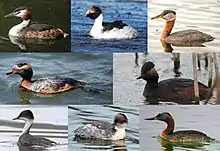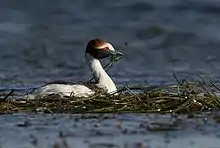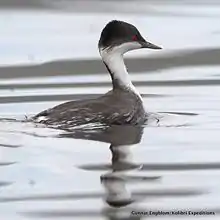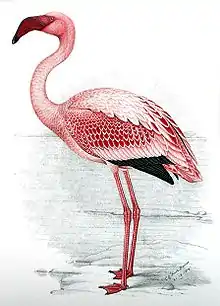Podiceps
Podiceps is a genus of birds in the grebe family. The genus name comes from Latin podicis, "rear-end" and ped, "foot", and is a reference to the placement of a grebe's legs towards the rear of its body.
| Podiceps Temporal range: Aquitanian to present | |
|---|---|
 | |
| Montage of eight species, featuring from left to right in three rows: P. cristatus, P. gallardoi, P. grisegena; P. auritus, P. nigricollis; P. taczanowskii, P. occipitalis, P. major. | |
| Scientific classification | |
| Domain: | Eukaryota |
| Kingdom: | Animalia |
| Phylum: | Chordata |
| Clade: | Dinosauria |
| Class: | Aves |
| Order: | Podicipediformes |
| Family: | Podicipedidae |
| Tribe: | Podicipedini |
| Genus: | Podiceps Latham, 1787 |
| Type species | |
| Colymbus cristatus[1] Linnaeus, 1758 | |
| Species | |
|
See text. | |
| Synonyms | |
| |
It has representatives breeding in Europe, Asia, North, and South America. Most northern hemisphere species migrate in winter to the coast or warmer climates.
They breed in vegetated areas of freshwater lakes, nesting on the water's edge, since their legs are set too far back for easy walking. Usually two eggs are laid, and the striped young may be carried on the adult's back. All the genus are excellent swimmers and divers, and pursue their fish prey underwater. Adults have striking breeding plumage, with no difference between the sexes. In winter, the plumage is subdued whites and greys.
Systematics
The genus Podiceps was erected by the English naturalist John Latham in 1787.[2] The type species was subsequently designated as the great crested grebe (Podiceps cristatus).[3] The genus name combines variants on the Latin podex, roughly meaning "rear-end", and pes, meaning "foot".[4]
The black-necked, Colombian, silvery, and Junin grebes are very closely related and were formerly sometimes separated as the genus Dyas. The great grebe has also sometimes been separated as the sole member of the genus Podicephorus.[5][6]
The genus contains nine species:[7]
| Image | Scientific name | Common Name | Distribution |
|---|---|---|---|
| P. andinus | †Colombian grebe - extinct (1977) | Colombia. | |
_-_(Podiceps_auritus).JPG.webp) | P. auritus | Horned grebe or Slavonian grebe | Eurasia and North America |
_(14).JPG.webp) | P. cristatus | Great crested grebe | Australasian, Europe and east across the Palearctic |
 | P. gallardoi | Hooded grebe | south-west Argentina |
.jpg.webp) | P. grisegena | Red-necked grebe | Japan to the East China Sea, and American |
 | P. major | Great grebe | West Peru, Paraguay, southeastern Brazil, Uruguay to Chile & southern Argentina |
2.jpg.webp) | P. nigricollis | Black-necked grebe or eared grebe | Europe, Asia, Africa, northern South America and the southwest and western United States |
 | P. occipitalis | Silvery grebe | Argentina, the Falkland Islands, Chile, and the western parts of Bolivia, Peru, Ecuador and Colombia. |
 | P. taczanowskii | Junin grebe | west-central Peru |
One of the very oldest fossil grebes known to date actually belongs to this genus. Regarding grebes, the fossil record leaves much to be desired, being quite complete for the last 5 million years before present but very incomplete before the Pliocene.
Fossil species of Podiceps are:
- †Podiceps arndti Chandler, 1990 (Piacenzian stage of North America)
- †Podiceps csarnotanus Kessler, 2009 (Piacenzian stage of Europe)
- †Podiceps discors Murray, 1967 (Piacenzian stage of North America)
- †Podiceps dixi Brodkorp, 1963 (Chibanian to the Tarantian stages of Florida, United States)
- †Podiceps howardae Storer, 2001 (Zanclean age of North Carolina, United States)
- †Podiceps miocenicus Kessler, 1984 (Tortonian age of Moldova)
- †Podiceps oligoceanus (Shufeldt, 1915) (Aquitanian age of North America)
- †Podiceps parvus (Shufeldt, 1913) (Gelasian to the Calabrian stages of North America)
- †Podiceps pisanus (Shufeldt, 1913) (Piacenzian stage of Italy)
- †Podiceps solidus Kuročkin, 1985 (Zanclean age of Western Mongolia)
- †Podiceps subparvus (Miller & Bowman, 1958)
- Podiceps? sp. (Late Pliocene of WC USA)
- Podiceps sp. (Early Pleistocene of Dursunlu, Turkey)[8]
Among the material assigned to P. parvus were bones of another species, which may or may not belong in this genus.[9]
References
- "Podicipedidae". aviansystematics.org. The Trust for Avian Systematics. Retrieved 2023-08-05.
- Latham, John (1787). Supplement to the General Synopsis of Birds. London: Printed for Leigh & Sotheby. p. 294.
- Mayr, Ernst; Cottrell, G. William, eds. (1979). Check-list of Birds of the World. Vol. 1 (2nd ed.). Cambridge, Massachusetts: Museum of Comparative Zoology. p. 148.
- Jobling, James A. (2010). The Helm Dictionary of Scientific Bird Names. London: Christopher Helm. p. 311. ISBN 978-1-4081-2501-4.
- Ogilvie, Malcolm Alexander & Rose, Chris (2003). Grebes of the World. B. Coleman, Uxbridge. ISBN 1-872842-03-8
- Harrison, Peter (1988). Seabirds (2nd ed.). Christopher Helm, London. ISBN 0-7470-1410-8
- Gill, Frank; Donsker, David, eds. (2019). "Grebes, flamingos, buttonquail, plovers, painted-snipes, jacanas, plains-wanderer, seedsnipes". World Bird List Version 9.2. International Ornithologists' Union. Retrieved 16 July 2019.
- Louchart, Antoine; Mourer-Chauviré, Cécile; Guleç, Erksin; Howell, Francis Clark; White, Tim D. (September 1998). "L'avifaune de Dursunlu, Turquie, Pléistocène inférieur: climat, environnement et biogéographie". Comptes Rendus de l'Académie des Sciences, Série IIA (in French and English). 327 (5): 341–346. Bibcode:1998CRASE.327..341L. doi:10.1016/S1251-8050(98)80053-0.
- Murray, Bertram G., Jr (May–June 1967). "Grebes from the Late Pliocene of North America" (PDF). Condor. 69 (3): 277–288. doi:10.2307/1366317. JSTOR 1366317.
{{cite journal}}: CS1 maint: multiple names: authors list (link)

